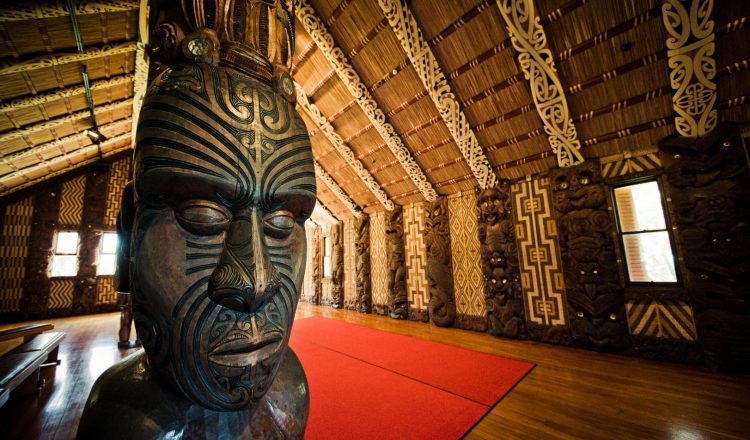마라에(Marae): 마을 공동 장소
우뚝 선 곳
마라에(marae)는 마오리 회의장이나 만남의 장소로 기능합니다. 보통 특정한 이위(iwi, 부족), 하푸(hapu, 하위부족) 또는 파나우(whanau, 가족)에 속하는 조각 건축물로 이루어진 울타리와 같이 복합체의 형태를 띕니다. 마라에는 모양과 크기가 각각 다르지만 마오리 문화의 중심입니다. 와이카토에 위치한 어느 한 부족의 투랑가와에와(turangawaewae) 마라에는 ‘우뚝 선 곳’이며, 전체 그룹을 하나로 모으는 신성한 유산입니다.
마라에는 회의, 축하, 결혼식, 장례식 및 교육 워크샵을 위한 장소로 활용됩니다. 마라에 안에는 조각된 미팅홀이나 화레누이(wharenui, 공유 공간)가 부족의 행사의 주요 지역이 될 것입니다. 그들은 인체의 일부, 보통 부족 조상의 일부분을 베어누이를 새겨둡니다. 정면 지붕에 새겨진 테코테코(Tekoteko)는 머리를, 정면의 마이히(Maihi, 거룻배)는 방문객을 두 팔 벌려 환영하는 모습을 나타냅니다. 벽에는 먼저 떠난 사랑하는 사람들의 그림과 전설 속 이야기들로 채워져 있습니다.
이 건물 밖에는 야외 모임을 위한 열린 공간, 이위가 함께 모일 수 있는 식당, 요리 공간 및 화장실이 있습니다. 요즘 마라에는 생활 공간으로 사용되지는 않습니다. 그러나 요즘도 종종 부족 모임이나 축하 행사가 있을 때 이위가 모두 모여 메인 홀에서 며칠 동안 함께 생활하기도 합니다. 공동체를 중요시 생각하는 이위는 함께 요리하고 먹으며 청소하면서 부족의 문제에 대해 토론합니다.
마라에 세부 사항
마라에와 회의장은 상호 보완적이며 공동체 정서의 구심점 역할을 한다. 회의장은 일반적으로 주요 중앙 건물이며 본관은 화려하게 조각되어 있습니다. 회의장은 티푸나(tipuna), 화레(whare) 와레누이(wharenui) 등과 같은 이름으로 불립니다. 거의 모든 경우에 조상의 이름을 따서 불리우며 조상을 나타내도록 상징적으로 구조화되어 있습니다. 따라서 앞쪽 지붕의 테코테코(tekoteko, 조각 형식의 그림)는 조상 머리를 나타내고, 마이히(maihi, 머리에서 땅을 향해 새겨진 각도)는 팔을 나타내며, 타후 또는 타아후(tahuhu/taahu, 건물 중앙의 능선 기둥)는 등뼈이며, 타후에서 포우포우(poupou, 벽을 둘러싼 조각상들)에 이르는 헤케(heke, 서까래)는 갈비각각 갈비뼈를 나타냅니다
포우포우는 일반적으로 다른 부족을 대표하는 조각상입니다. Poupou는 같은 소속 내 식별자로 기능합니다. 일반적으로 타후후를 들고 있는 두 사람은 하늘의 아버지 랑기(Rangi)와 지구의 어머니 파파투아누쿠(Papatūānuku)를 나타냅니다. 다른 해석의 여지가 있지만 회의장의 이름은 조상의 이름을 따서 불리는 것으로 봅니다. 따라서 내부로 들어가면 조상의 가슴 속으로 들어가는 것처럼 보입니다. 또한 Marae-Atea-o-Tumatuenga에서의 상호작용은 보통 집안에서 일어나는 상호작용과 크게 다를 수 있고, 또 달라야 합니다. 룽고(Rongo, 평화의 신)의 집은 이러한 분위기 속에서 사람들이 서로 교류해야 한다고 믿습니다.
따라서 d)는 늑골을 나타낸다. 푸푸는 보통 다른 부족을 대표하는 조상이다. 그러면 푸푸는 소속감에서 식별자로 기능합니다. 보통 두 사람이 타후를 들고 있는 직립은 하늘의 아버지인 랭기와 땅의 어머니인 파파투아누쿠 사이의 연관성을 나타냅니다. 다른 해석도 있지만, 만남의 집은 조상의 이름을 따서 지은 것이라는 것이 적절하다. 따라서 집에 들어가면 조상들의 품으로 들어가는 것으로 볼 수 있다. 또한 마라에뜨아-오-투마투엥가에서의 사람 간의 상호작용은 보통 집 안에서 권장되는 상호작용의 유형과 크게 다를 수 있고, 또 크게 달라야 한다. 룽고의 집 안은 이러한 분위기 속에서 사람들이 서로 교류해야 한다고 믿고 있다.
와레(Whare)
와레 카이(Whare Kai)는 식당입니다. 와레 카이 (Whare Kai) 별도의 존재로, 반드시 물리적 실재로서가 아니라 어떤 경우에는 개념으로 존재합니다. 타푸(tapu, 신성체)의 개념은 어디에서 음식/음료를 먹거나 먹을 수 없는지 규정합니다. 마오리족에게 음식은 노아(noa, 일반체)이며 타푸와는 반대 개념입니다. 티푸나 와레(tipuna ware, 만남, 조상 가옥)는 타푸이고 따라서 그곳에서는 음식을 먹을 수 없는 반면, ware kai는 이러한 타푸로부터 자유롭습니다 – 이 둘은 서로 반대편에 동떨어져 있습니다.
기타 건물 및 구조물
많은 마라에 근처에 교회가 있습니다. 이는 마라에에서 일상적으로 생활하는 사람들 곁에 신이 늘 존재하고 있음을 알고 있다는 의미입니다. 많은 마라에들은 또한 돌아가신 조상을 여전히 생명의 살아있는 개체로 모셔놓은 우루파(urupa, 공동묘지)를 근처에 두고 있지만 건물 안에서 제사를 지내는데 마오리인에게 의미 있는 삶과 죽음의 하나됨에 대한 신념을 반영하여 호노 이 와이루아(hono-i-wairua, 영혼들이 모이는 곳)에서 화이코로(whaikorero, 정언)를 통해 경의를 표합니다. 테 훙아 오라(Te hunga ora, 산사람)는 테 훙아 마테(te hunga mate, 죽은 사람)와 테 훙아 오라(te hunga ora)의 합성어입니다. 와이코로(whaikorero)에서는 이러한 개념이 자주 눈에 뜨입니다. 어떤 마라에에는 아주 특별한 선조 또는 2차 세계대전 전사자를 기리는 기념비가 마라에나 와레 옆에 위풍당당하게 세워져 있기도 합니다. 마지막으로 와레누이(Wharenui)와 와레 카이(Whare Kai) 뒤쪽에는 목욕재와 화장실이 눈에 잘 띄도록 배치되어 있습니다.
마라에 들어가기
운좋게 손님으로 마라에로 초대받게 된다면 먼저 포히리(powhiri)로 알려진 의식을 통해 공식적인 환영을 받습니다. 이 환영 의식은 여러 단계로 구성되어 있고 모든 절차가 끝난 후에야 안으로 들어갈 수 있습니다. 마라에에서 가져야 할 기본 에티켓은 정중한 태도로 일관할 것과 사진을 찍고 싶은 경우엔 먼저 허가를 구해야 한다는 점입니다. 건물로 들어갈 때는 신발을 벗고 내부에서는 음식을 먹거나 마실 수 없습니다. 포히리는 노래와 춤(하카 등)이 포함되며, 무표정한 얼굴로 이에 대한 경의를 표해주시면 좋습니다.

















































